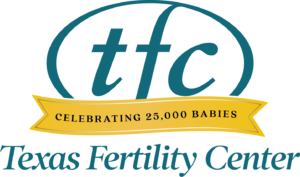
IVF Takes Fertility Treatment to the Next Level
In vitro fertilization, or IVF, is one of reproductive medicine’s greatest advances. It allows women and men to bypass many of the barriers to conception, resulting in the births of more than 12 million babies worldwide.
Many cases of infertility will only require basic treatments, such as fertility medications or artificial insemination (IUI). However, our TFC fertility specialists recommend in vitro fertilization when needed for patients who require extra help to overcome infertility.
What can you expect from an in vitro fertilization cycle?
Our San Antonio fertility doctors will guide you through each step of this advanced fertility treatment. You can expect the following steps to be part of your IVF journey.
- The use of ovarian stimulation medications daily, with ultrasound and laboratory appointments every few days, for about two weeks
- An egg retrieval procedure: an outpatient procedure in which eggs will be obtained from the fluid-filled spaces (follicles) present in each ovary
- The in vitro fertilization process, when sperm (from the patient’s partner or a donor) are exposed and introduced with the eggs, either using conventional insemination or intracytoplasmic sperm injection (ICSI)
- An ultrasound-guided embryo transfer, in which the embryo is introduced inside the uterus
In vitro fertilization is a highly successful treatment. This is especially true when using high-quality eggs and working with an experienced fertility doctor and laboratory.
Who can benefit from in vitro fertilization?
Many different types of patients can benefit from IVF. In fact, our San Antonio fertility doctors often recommend this treatment for the following cases.
- Women of advanced maternal age (older than 35), especially if they are struggling to begin their family later in life
- Women with scarring from endometriosis or tubal infertility
- Men facing severe male infertility
- Women and men who have had multiple miscarriages
- Couples who have undergone and failed other types of treatment cycles
- Patients who want to pursue preimplantation genetic testing (PGT) to decrease miscarriage risk due to age, or test embryos for known familial genetic illness
To make parenthood possible for all these groups of patients, our fertility doctors diligently follow the latest literature and scientific studies. This allows them to develop the best treatment plan for each patient’s unique needs.
What should you look for in an IVF laboratory?
The laboratory plays an important role in IVF success. As a result, our fertility specialists work with state-of-the-art embryology and andrology laboratories run by Ovation® Fertility. These facilities offer many benefits to women and men who are hoping to conceive.
An experienced team. Highly skilled embryologists perform in vitro fertilization and genetic testing on the embryos before the embryo transfer. Every employee at Ovation San Antonio embraces the highest standards.
Comprehensive capabilities. The laboratory offers advanced procedures, including preimplantation genetic testing, advanced sperm function testing and intracytoplasmic sperm injection (ICSI).
Industry-standard credentials. Patients feel confident because the lab meets or exceeds all local, state and national standards, including certification by CLIA, CAP and the FDA. Not only that, but the lab director and associate lab director also serve as CAP inspectors. This means they inspect other fertility labs across Central Texas and the United States.
The miracle of IVF has brought great joy to many Central and South Texas families. Our San Antonio fertility specialists celebrate each success and work hard to make parenthood possible for even more women and men. Contact us to schedule an appointment and learn more about how our San Antonio fertility doctors can help you welcome a baby.



